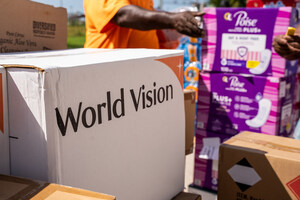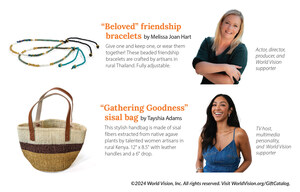New Study: Girls More Likely to Use Social Media to Support Causes
Girls More Likely than Boys to Say They've Become More Aware of the Needs of Others Because of Social Media
This Weekend 200,000 Teens Expected To Fast from Food
Responding to Haiti Quake and Global Food Crisis
World Vision's 30 Hour Famine, February 25th, 26th
SEATTLE, Feb. 23, 2011 /PRNewswire-USNewswire/ -- According to a new 30 Hour Famine study, four out of five teens (80 percent) use social media, almost half (44 percent) say they've become more aware of the needs of others as a result of their use of social media like Facebook and Twitter and about one in three (34 percent) "friend," "like" or "follow" charitable organizations or causes they believe in. The survey commissioned by World Vision, an international relief and development group, also reveals that girls are more likely than boys to say they've become more aware of the needs of others as a result of their use of social media (51 percent vs. 38 percent) The study was conducted online in January by Harris Interactive among more than 500 youth ages 13 to 17 years old.
GIRLS MORE CHARITABLE?
Girls More Likely Than Boys to "friend," "like" or "follow" Charities They Support And Causes They Believe in (41 percent vs. 27 percent)
Girls More Likely to Support Charities Symbolically (43 percent vs. 31 percent) And Vocally (38 percent vs. 27 percent)
"While social media may be decried by some for the time teens today spend on it, the truth is it can help today's youth learn more about important things in life. More than two in five teens say they have become more aware of the needs of others because of their use of Facebook or Twitter. One-third say they 'friend,' 'like,' or 'follow' charitable causes they believe in, which helps spread the word among their circle. This is teens using social media for social good," says Regina Corso, Senior Vice President, Harris Poll Public Relations and Youth Research with Harris Interactive.
This weekend, some 200,000 American teens will go hungry in an effort to help Haiti earthquake survivors and fight global hunger through World Vision's 30 Hour Famine. This year, more than 155 youth groups have already contacted World Vision about designating 30 Hour Famine funds to long-term Haiti recovery. Last year $1.2 million went to Haiti Relief. This year, many groups will also give up access to social media (going on a media fast) to raise money and hunger awareness.
Michele Tvedt, World Vision's 30 Hour Famine Manager says, "I'm really excited and grateful that teens here can have a direct impact on teens and children in Haiti." Tvedt has personally done The Famine for 13 years, adding up to more than 390 hours over the years. Since 30 Hour Famine started in 1992, groups participating in Famine events have raised more than $140 million to fight global hunger.
February 25th & 26th, (there's another national date: April 29-30) hundreds of thousands of teens will participate in World Vision's 20th annual 30 Hour Famine, forsaking food for 30 hours to get a taste of what the world's poorest children face. Prior to the event, teens raise funds by explaining that $1 can help feed and care for a child a day. So $1 for each hour they'll fast, $30, can feed and care for a child for a whole month. As they fast, teens consume only water and juice as they participate in local community service projects (food banks, soup kitchens and homeless shelters). Part of the funds from this year's 30 Hour Famine will go toward long-term relief in Haiti. Last year's 30 Hour Famine raised $10.4 million with funds going to fight global hunger. This year's fund-raising goal is $11 million.
Tonight, almost 1 billion people worldwide will go to bed hungry - that's one out of every six people on earth. 22,000 children die each day from hunger and preventable diseases. Chronic poverty, affecting half the people on earth, is the cause. Nearly 3 billion people live on less than $2 a day.
Where does 30 Hour Famine money go? Haiti, Ethiopia, Kenya, Somalia, Uganda, Sudan, South Sudan, Mauritania, Pakistan, Zambia, Zimbabwe and other targeted spots where famine, conflict and other crises make children vulnerable. Some 30 Hour Famine funds are also used to address poverty here in the U.S.
World Vision works in 100 countries, helping approximately 100 million people every year.
For info: www.30hourfamine.org or call 800-7-FAMINE
Or visit our Facebook fan page at www.facebook.com/wv30HF
30-Hour Famine groups available for interviews weekend of Feb 25-26 in these and other cities:
North Carolina (Charlotte)
St. John's Episcopal – one of the nation's top 30 Hour Famine fundraisers raised almost $80,000 last year.
Norwalk, Connecticut
Saint Philip Roman Catholic Church – raised almost $22,000 last year.
Oregon (Portland area)
Beaverton Christian Church – at least 800 teens expected at 30 Hour Famine rally.
30 Hour Famine Survey 2011 Facts The poll was conducted online by Harris Interactive on behalf of World Vision, an international Christian relief and development organization, between January 20 and 31, 2011, among 523 U.S. youth ages 13 to 17 years old, of whom 274 are girls and 249 are boys. For complete methodology, including weighing variables, please contact John Yeager.
About World Vision – World Vision is a Christian relief and development organization dedicated to helping children and their communities worldwide reach their full potential by tackling the causes of poverty. World Vision serves the world's poor regardless of a person's religion, race, ethnicity, or gender. For more information, visit www.worldvision.org.
SOURCE World Vision U.S.
WANT YOUR COMPANY'S NEWS FEATURED ON PRNEWSWIRE.COM?
Newsrooms &
Influencers
Digital Media
Outlets
Journalists
Opted In






Share this article